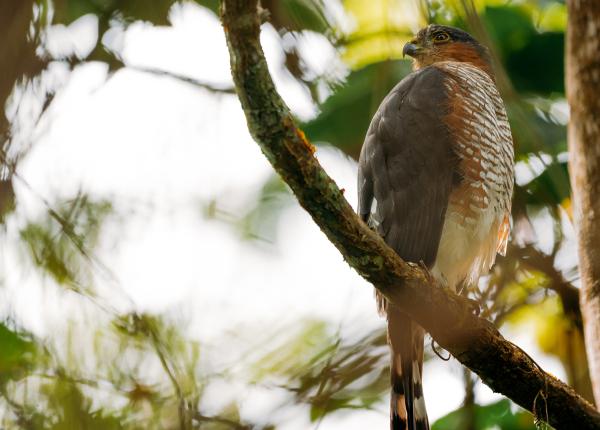Did You Know?
- The Puerto Rican Sharp-shinned Hawk population was greatly reduced by Hurricane Maria, which hit the Caribbean in 2017.
- The Puerto Rican Sharp-shinned Hawk is currently classified as a subspecies of the Sharp-shinned Hawk, but recent genetic research has revealed compelling evidence that they may merit full species status.
How The Peregrine Fund is Helping
After the devastating effects of Hurricane Maria, The Peregrine Fund began to provide supplemental food so the remaining Sharp-shinned Hawks could become healthy enough to breed. As pairs began to lay eggs, conservationists carefully moved some of these eggs into incubators to hatch in a secure, climate-controlled breeding facility on the island. Since these hawks normally produce a second set of eggs if the first set is lost, they were able to raise chicks in the safety of a facility without compromising the wild parents’ success. In the first year of captive-rearing, conservationists raised and released six young, while the wild pairs raised only two.
The future looks bright for the Sharp-shinned Hawk. Through an ever-growing range of knowledge and expanded collaborative efforts, The Peregrine Fund, along with the help of countless entities and individuals, will continue to help save this species. Read more to learn about everything The Peregrine Fund is doing to help conserve this species.
Where It Lives
The Puerto Rican Sharp-shinned Hawk is an endangered species endemic to the island of Puerto Rico. It lives in mature and secondary forests and shade coffee plantations. Unlike the Sharp-shinned Hawk (Accipiter striatus velox) found in North America, the Puerto Rican Sharp-shinned Hawk does not migrate and remains on the island all year round.
What it Does
Adult Puerto Rican Sharp-shinned Hawks have dark gray backs and reddish-orange bars that run horizontally on their breasts. They have long legs and long tails; the latter is marked by wide bands. They have dark eyes, and a yellow cere and legs. These birds spend most of their time below the forest canopy, but can occasionally be seen flying over the canopy while traveling or during the breeding season during courtship displays.
During breeding season, they can be quite vocal.
Why it Needs Our Help
The cause of this species’ population decline is still unknown; however, it may have been the result of several factors. These include habitat loss, forest fragmentation, high nestling mortality rate caused by a parasitic nest fly (Philornis sp.), nest predation by the Pearly-eyed Thrasher (Margarops fuscatus), and changes in the forest composition and structure due to natural disturbances such as hurricanes. The Puerto Rican Sharp-shinned Hawk has been on the U.S. Endangered Species List since 1994.
In 2017, Hurricane Maria decimated the forests of Puerto Rico. The majority of mature trees were blown down, uprooted, or had their leaves stripped off. Without foliage, nestlings don’t have shelter from heat, rain, or predators. Even adult birds are subject to starvation because their main prey—small birds like tanagers, warblers, and vireos— also depend on adequate forest habitat.
What it Eats
The Puerto Rican Sharp-Shinned Hawk is equipped with long thin legs, ideal for trapping small, aerial prey. It feeds mostly on smaller birds and insects but it has also been known to capture small lizards from tree branches.
Nests, Eggs, and Young
The adult male and female work together to build a stick nest. The nest is placed in a dense stand of trees. After the nest is ready, the female will lay her eggs. She will incubate them for 30–32 days. The nestlings fledge in three to four weeks. When these young hawks reach one year old, they will be able to find a mate and raise their own nestlings.
Puerto Rican Sharp-shinned Hawk and the World Center for Birds of Prey
Though the World Center for Birds of Prey is far from Puerto Rican Sharp-shinned Hawk habitat, the center offers fun ways to learn about birds of prey. Interactive activities, tours, interesting videos and a children's room with activities from coloring sheets to quizzes to costumes are all available for our guests. We also have knowledgeable on-site staff to answer any questions you may have.
References:
Curti, M. 2002. Raptors of the Caribbean: Education & Conservation Resource Guide. The Peregrine Fund.









